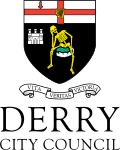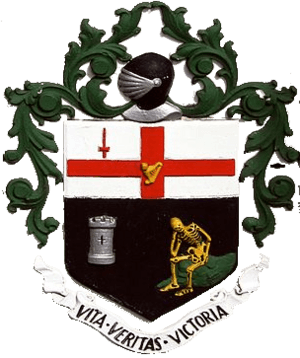Derry City Council facts for kids
Quick facts for kids Derry City Council |
|
|---|---|
 |
|
| Area | 387 km2 (149 sq mi) Ranked 18th of 26 |
| District HQ | Derry |
| Catholic | 60% |
| Protestant | 30% |
| Country | Northern Ireland |
| Sovereign state | United Kingdom |
| EU Parliament | Northern Ireland |
| Councillors | 40 |
Derry City Council (Irish: Comhairle Cathrach Dhoire; Ulster-Scots: Derry Cittie Cooncil) was a local government group for the city of Derry in Northern Ireland. It was like a city council that helped run things in the area.
In April 2015, Derry City Council joined with Strabane District Council. They formed a new, bigger council called Derry and Strabane District Council.
Before the change, the council helped almost 108,000 people. This made it the third-largest of the 26 district councils in Northern Ireland at that time. The council had 30 members, called councillors. They were chosen every four years from five different areas. The council meetings were held in The Guildhall. The last mayor for 2014–2015 was Brenda Stevenson. Gary Middleton was the last deputy mayor.
Contents
History of the Council
The council that became Derry City Council started in 1973. It was formed by joining two older areas: Londonderry county borough and Londonderry rural district. Before 1973, these areas were managed by a group called the Londonderry Development Commission. This commission aimed to create a "new town."
In 1984, Londonderry City Council officially changed its name to Derry City Council. This change was for the area it managed. The city itself kept the name "Londonderry." You can learn more about this in the Derry/Londonderry name dispute.
Coat of Arms and Motto
A coat of arms is a special design that represents a city or family. Derry's coat of arms has a few interesting parts. It shows a skeleton and a castle with three towers on a black background.
At the top of the shield, there is a red cross and a sword on a white background. This part shows the arms of the City of London. In the middle of the red cross, there is a gold harp.
The city's arms were officially confirmed in 1613. At that time, the city was renamed Londonderry. The mayor asked for the "chief of London" part to be added. This is the top section with the cross and sword.
What the Symbols Mean
People have different ideas about what the older parts of the arms mean. These are the skeleton and the castle, before the London symbols were added.
One idea is that the castle is linked to an old castle from the 1300s. This castle was in Greencastle and belonged to an important leader.
The most common idea about the skeleton is that it belonged to a knight. This knight was supposedly starved to death in the castle in 1332. Another idea is that it shows Cahir O'Doherty. He was put to death after Derry was taken by the English army in 1608.
However, a report in 1979 looked into the city's arms. It found that there was no real proof for these popular stories about the skeleton. The report said the skeleton was "purely symbolic." This means it was just a symbol and not a real person.
The harp in the middle of the cross was on the original arms in 1613. But it was left out of later designs. In 2002, Derry City Council asked to have the harp put back. It was officially restored to the city's arms in 2003.
The motto on the coat of arms is in Latin: "Vita, Veritas, Victoria." This means "Life, Truth, Victory" in English.
The Mayor of Derry
The 'Mayor of Derry' was an important role given to a citizen of Derry. This person was usually a member of the Derry City Council. The council members chose one of their own to be mayor for one year.
The last mayor of Derry City Council was Brenda Stevenson. The last deputy mayor was Gary Middleton.
The role of mayor has a long history. The first leader of the city was called a "provost" in 1604. In 1613, this job changed to "mayor." John Rowley was the first person to be mayor.
For a long time, most mayors were Unionists. But in later years, more mayors were Nationalists. This change reflected the people living in the city and on the council. In the 1990s, the role of mayor was often shared. A nationalist councillor would be mayor one year, and a unionist councillor the next.
Shadow Council for Young People
Derry used to have a special group called the Shadow Council for young people. This group ran from about 1999 to 2008. It was made up of young people aged 16 to 22. They were chosen from different areas and groups in the city.
The Shadow Council worked with Derry City Council. They even chose a "Junior Mayor" to speak for them to the public and the news.
Population of the Area
The area that Derry City Council covered had 107,877 people living there. This number comes from the 2011 Northern Ireland census.



